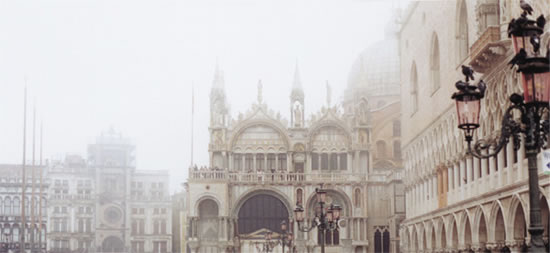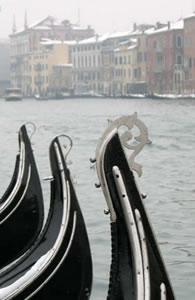With glass windows open like eyes under delicately arched brows, the buildings of Venice watch over the waters in utter calmness. Venetians have good reason to call their city La Serenissima - the most serene.
|
Venice awakes each morning with a refreshing absence of the speeding cars and roaring mopeds that infest other Italian cities. Her citizens make their way on foot or by boat through an ancient maze of narrow streets and winding canals.
Unfortunately, the serenity is now broken by swarms of tourists that collect in the campi (squares) and thoroughfares of the city, searching out its wealth of museums and landmarks.
These visitors often overlook the real Venice, which lies hidden in the romantic back streets and residential quarters of the city.
|
 |
A short history..
Driven first by Attila's hordes, then by conquering Lombard’s, Roman refugees joined fishermen on the low barrier islands of the swampy lagoon. An unsuccessful attack by Charlemagne in 810 led to the settlement of the inner islands that constitute the modern city.
In 828, two Venetian merchants stole St. Mark's remains from Alexandria and established the city's eminence under a new patron saint. By the 11th century, ties to Constantinople and marine prowess had established Venice as the dominant middleman for trade with the Middle East.
 |
In 1204, Venice sent the penniless armies of the Fourth Crusade to raid Constantinople; the spoils of this campaign filled Venetian squares and treasuries with new prosperity.
After consolidating its oligarchic government in the 14th century, the Venetian Republic defeated its rival Genoa in 1380 and expanded onto the Italian mainland.
Over the next three centuries, jealous European powers to the west and unstoppable Ottoman Turks to the east whittled away La Serenissima's empire, while the discovery of ocean routes to the Far East robbed it of its monopoly on Asian trade.
|
By the time Napoleon conquered it in 1797, idle Venice was little more than a decadent playground. French and Austrian rule capped off the glory days as the development of industry at Mestre drew away the archipelago's working population.
Today Venice consists of two worlds, hosting tourists and cameras from around the globe in Piazza San Marco and housing locals in the sparsely populated back streets of Cannaregio and the Ghetto. Uniting them are the architectural gems of a glorious past and the intertwining canals, the true arteries of the city.
|





